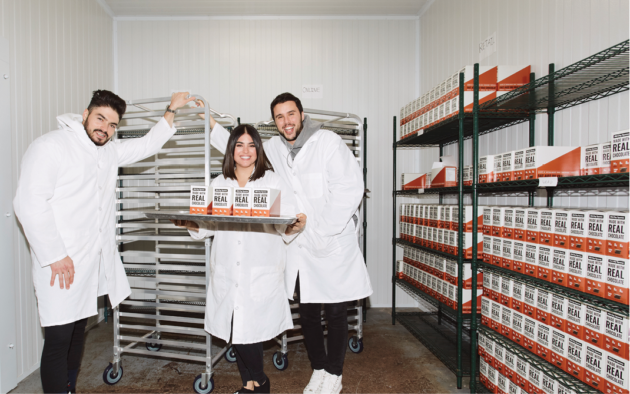
For many large food companies, snack consumption at home has helped to offset big drops in sales through closed foodservice and other channels. Read more of this industry trend cover story from the latest issue of Food in Canada.
“I’m gnoshing more,” said Stephen, 69. “But I’m also paying more attention to what I eat. I’m all in for chewy things made with healthier ingredients. But I gotta have my old favourites too.” He also now orders his snacks online, along with the heavier grocery items he has delivered to his home in southern Ontario. “The pandemic has made in-person shopping more complicated,” he adds. “Ordering online makes my life easier.”
My brother’s not alone. As recent sales data, market studies and other sector metrics suggest, consumers in Canada and other industrialized countries have been chowing down snack foods in record amounts since early 2020, when the pandemic began confining people to their homes.
And as the global health crisis rages on, snack-makers are working feverishly to understand the dynamics behind the uptick in demand and to quantify and measure the changing nature of people’s snacking preferences and shopping habits in an effort to develop new products — or give trendy tweaks to nostalgic favourites — that will help to sustain growth in the $1.4 trillion sector.
THE COVID EFFECT
According to recent data from Upwork and Statistics Canada, more than 40 per cent of Americans and Canadians have been working remotely since March. New survey results suggest the vast majority of those people want to continue doing so once the pandemic ends. Millions of students, as well as owners and workers of restaurants, bars and other shuttered businesses deemed non-essential also remain cooped-up at home.
So, it’s no surprise that the sales of snacks — defined as small portions of ready-to-eat packaged, processed or fresh foods that people consume between meals — have soared during this period.
For many large food companies, snack consumption has helped to offset big drops in sales through closed foodservice and other channels like vending machines. PepsiCo, Kellogg’s and Mondelez, for example, had strong sales growth in 2020, beating gloomy pre-pandemic predictions by Wall Street analysts. These companies all had double-digit quarterly sales increases across their snack brand portfolios in 2020 — from sweet or salty treats to fresh fruits and vegetables.
“Many people already embed snacking in their daily lives,” says Julie Anne Philip, director of consumer insights and analytics at Mondelez Canada. “The pandemic has accelerated that.” Philip points to the results of a second annual global report by Mondelez released in November that used an online survey of Canadians to gain insight into their snacking habits and how the pandemic impacted them. The survey found that snacking was a “lifeline” for 42 per cent of respondents of all demographics, though that figure that climbed to almost 60 per cent among Millennials and Generation Z.
Nearly two-thirds of respondents also identified snacking as a highlight in their day, including nearly three-quarters of parents working from home. Snacking was also seen by many as a way of combatting solitude.
The report also found major upticks in healthier and activity-related snacks as well as a definite move to purchasing snacks online — something 51 per cent of respondents say they intend to continue doing once the pandemic ends. “The experience of purchasing online,” says Philip, “has also greatly improved.”
NOSTALGIA MATTERS
Nearly half of respondents also reported buying snack brands they enjoyed as kids and that brought back good childhood memories. “That suggests that in the heat of the pandemic, snacking was a source of comfort for people (and) connection with their past and the community,” says Philip. Mondelez, for example, has seen strong sales for its iconic snack food brands, including Oreo cookies, Premium Plus crackers and Cadbury candy bars like the Canadian-made Caramilk (one of my Boomer brother’s all-time favourites). Kellogg Canada is also serving up several products this year that focus on nostalgia including new flavours of Cheez-It Crackers and Pringles, Special K Whole Blueberries cereal, Eggo Chocolate cereal and bite-size Pop Tarts. Also on its product list is a limited-edition run of old-time Apple Jacks cereal and gaily-coloured Rice Krispies Spring Edition.
Mississauga-based snack maker Super Pufft has also experienced a pandemic business boost. It’s famous for its Lucky Elephant pink candy carnival popcorn, but now derives growing revenues from private label production of salty and extruded snacks for many of Canada’s biggest food retailers. “Snacks is always a fast-moving category that is affected by trends and events like the Super Bowl,” says Super Pufft sales manager Mayson Jaffer. “The pandemic caused a big spike in March, when there was panic buying going on. But sales have remained steady for us after that. Snacks are comfort food. When times are hard, people want and need their snacks.”
DIFFERENT NICHE MARKETS
But not all snack-makers have been able to make hay from the pandemic. Private-label snack bar maker and exporter Yourbarfactory, for example, has seen orders plunge from company-clients that target school kids, working people and athletes with single-serve, portable snacks.

“Schools and gyms are closed and people aren’t going to the office,” says Yourbarfactory owner Martin Joyal. “We’re down 15 to 20 per cent for 2020 compared to 2019.” Single-serve bars aren’t a popular snack food for people at home, he says, and people are eating more baked goods and fresh foods. “The whole category is down 50 per cent,” he adds. “And vending machines are dead. Everything’s closed and people are afraid to even touch the buttons.”
Another Canadian snack bar maker, start-up Mid-Day Squares, has had a better pandemic experience, however. The company sells three flavours of high-end functional chocolate bars online and at health food stores across Canada. Co-owner Nick Saltarelli says store sales “fell off a cliff” last February when the pandemic hit, but online sales “skyrocketed.” Saltarelli owns and operates the company with his wife Lezlie Karls and her brother Jake out of a new $3-million facility.

What explains their strong sales, says Saltarelli, are two dove-tailing factors — the company’s cutting-edge online sales platform and the loyalty of its tech-savvy, fit and prosperous young clientele. “We run our online business like Amazon does and deal directly with the customer,” he says. “Good planning and good fortune set us up for success in these bad times.”
 — BY MARK CARDWELL —
— BY MARK CARDWELL —
Print this page
